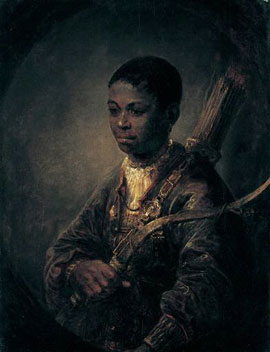October has been designated “Black History Month”, so this week’s picture is the Dutch artist Govaert Flinck’s beautifully solemn, reflective portrait of a black African dressed up as A Young Archer. This small, oval painting was created in about 1640, a few years after Flinck gave up working as an assistant in the studio of Rembrandt and set up as an independent painter in Amsterdam. It came to this country in 1848, when it was purchased by the Fourth Marquess of Hertford as an autograph Rembrandt, and was for many years regarded as one his subtlest studies in expression. In an article in The Times, published in 1889, the work was described as Rembrandt’s “celebrated Negro Archer”. But in 1913, when the painting was cleaned, Rembrandt’s apparent signature turned out to be a bogus later addition, covering up the remains of an earlier signature beginning with the letter “f”. By 1928, it had been reattributed to the Govaert Flinck, who created numerous paintings in the style of his master in the 1630s and 1640s, a time when there was considerable demand in Amsterdam for pictures in the fashionable Rembrandt manner.
Flinck was born in 1615, the son of a merchant in Cleves in the Lower Rhine Province. After being apprenticed to a minor Friesian artist he went to Amsterdam, to study in Rembrandt’s studio, in about 1633. He set up on his own three years later and quickly prospered, earning a reputation as a learned connoisseur as well as a talented painter. His first biographer, Arnold Houbraken, was especially impressed by his large studio, filled with the painter’s props and the fruits of his collector’s zeal: a valuable collection of oriental works of art, numerous paintings and drawings, suits of armour, chests stuffed with articles of costume, and...

ITP 233: A Young Archer by Govaert Flinck
17-10-2004

